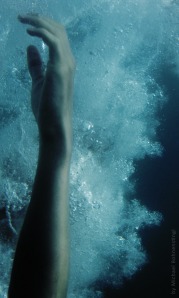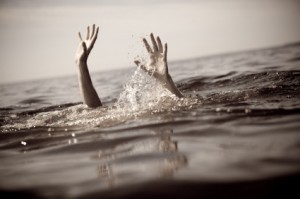[/caption]
Yes, I can post links to Twitter and Facebook - and I did - but this is so important that I feel the need to pass it along in any way possible. As a result, many e-mails were sent and I'm reposting it here, since Mario very kindly gave me permission to repost it in e-mail and here. Thank you again, Mario, for helping to dispel the myths perpetuated by television and saving lives (this on top of being a hero serving your country). You can read the original post on his blog here.
This Article Was Written By Mario Vittone
Mario Vittone has nineteen years of combined military service in the U.S. Navy and Coast Guard. His writing on maritime safety has appeared in Yachting, SaltWater Sportsman,On-Scene, Lifelines, and Reader's Digest magazine. He has lectured extensively on topics ranging from leadership to sea survival and immersion hypothermia. He is a marine safety specialist with the U.S. Coast Guard.
If you have any questions at all – please post them in the gCaptain forums under “maritime safety.”
disclaimer:The views and opinions expressed by the author are not necessarily those of the Department of Homeland Security or the U.S. Coast Guard.
For more water survival tips be sure to visit USCG rescue Swimmer Mario Vittone’s gCaptain Page. Or follow Mario on Facebook.
[caption id="attachment_4361" align="alignright" width="300" caption="TV doesn't imitate real life here."]
[/caption]
Drowning Doesn’t Look Like Drowning
Drowning? Not likely.
The new captain jumped from the cockpit, fully dressed, and sprinted through the water. A former lifeguard, he kept his eyes on his victim as he headed straight for the owners who were swimming between their anchored sportfisher and the beach. “I think he thinks you’re drowning,” the husband said to his wife. They had been splashing each other and she had screamed but now they were just standing, neck-deep on the sand bar. “We’re fine, what is he doing?” she asked, a little annoyed. “We’re fine!” the husband yelled, waving him off, but his captain kept swimming hard. ”Move!” he barked as he sprinted between the stunned owners. Directly behind them, not ten feet away, their nine-year-old daughter was drowning. Safely above the surface in the arms of the captain, she burst into tears, “Daddy!”
How did this captain know, from fifty feet away, what the father couldn’t recognize from just ten? Drowning is not the violent, splashing, call for help that most people expect. The captain was trained to recognize drowning by experts and years of experience. The father, on the other hand, had learned what drowning looks like by watching television. If you spend time on or near the water (hint: that’s all of us) then you should make sure that you and your crew knows what to look for whenever people enter the water. Until she cried a tearful, “Daddy,” she hadn’t made a sound. As a former Coast Guard rescue swimmer, I wasn’t surprised at all by this story. Drowning is almost always a deceptively quiet event. The waving, splashing, and yelling that dramatic conditioning (television) prepares us to look for, is rarely seen in real life.
The Instinctive Drowning Response – so named by Francesco A. Pia, Ph.D., is what people do to avoid actual or perceived suffocation in the water. And it does not look like most people expect. There is very little splashing, no waving, and no yelling or calls for help of any kind. To get an idea of just how quiet and undramatic from the surface drowning can be, consider this: It is the number two cause of accidental death in children, age 15 and under (just behind vehicle accidents) – of the approximately 750 children who will drown next year, about 375 of them will do so within 25 yards of a parent or other adult. In ten percent of those drownings, the adult will actually watch them do it, having no idea it is happening(source: CDC). Drowning does not look like drowning – Dr. Pia, in an article in the Coast Guard’s On Scene Magazine, described the instinctive drowning response like this:
- Except in rare circumstances, drowning people are physiologically unable to call out for help. The respiratory system was designed for breathing. Speech is the secondary or overlaid function. Breathing must be fulfilled, before speech occurs.
- Drowning people’s mouths alternately sink below and reappear above the surface of the water. The mouths of drowning people are not above the surface of the water long enough for them to exhale, inhale, and call out for help. When the drowning people’s mouths are above the surface, they exhale and inhale quickly as their mouths start to sink below the surface of the water.
- Drowning people cannot wave for help. Nature instinctively forces them to extend their arms laterally and press down on the water’s surface. Pressing down on the surface of the water, permits drowning people to leverage their bodies so they can lift their mouths out of the water to breathe.
- Throughout the Instinctive Drowning Response, drowning people cannot voluntarily control their arm movements. Physiologically, drowning people who are struggling on the surface of the water cannot stop drowning and perform voluntary movements such as waving for help, moving toward a rescuer, or reaching out for a piece of rescue equipment.
- From beginning to end of the Instinctive Drowning Response people’s bodies remain upright in the water, with no evidence of a supporting kick. Unless rescued by a trained lifeguard, these drowning people can only struggle on the surface of the water from 20 to 60 seconds before submersion occurs.
(Source: On Scene Magazine: Fall 2006)
This doesn’t mean that a person that is yelling for help and thrashing isn’t in real trouble – they are experiencing aquatic distress. Not always present before the instinctive drowning response, aquatic distress doesn’t last long – but unlike true drowning, these victims can still assist in their own rescue. They can grab lifelines, throw rings, etc.
Look for these other signs of drowning when persons are in the water:
- Head low in the water, mouth at water level
- Head tilted back with mouth open
- Eyes glassy and empty, unable to focus
- Eyes closed
- Hair over forehead or eyes
- Not using legs – Vertical
- Hyperventilating or gasping
- Trying to swim in a particular direction but not making headway
- Trying to roll over on the back
- Ladder climb, rarely out of the water.
So if a crew member falls overboard and everything looks O.K. – don’t be too sure. Sometimes the most common indication that someone is drowning is that they don’t look like they’re drowning. They may just look like they are treading water and looking up at the deck. One way to be sure? Ask them: “Are you alright?” If they can answer at all – they probably are. If they return a blank stare – you may have less than 30 seconds to get to them. And parents: children playing in the water make noise. When they get quiet, you get to them and find out why.




2 comments:
Such a valuable post! We have a house at the lake and the kids are in the water non-stop. Drowning is always one of my top fears, this will help me identify the "real-life" warning signs. Much appreciated!All the Best,Heather
Very interesting. I spent many years as a lifeguard and was fortunate enough not to ever have to rescue anyone. swapbot-stampkrl
Post a Comment